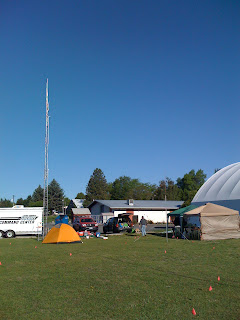We were very fortunate to get the use of the county sheriff's emergency services trailer, which had some amateur radio gear already installed in it.
As it turns out, this particular emergency trailer (see photo below) had never been used until this Field day!
In a way it was fortunate as we uncovered several wiring and grounding issues that we addressed.
This worked out to be a great operating station and was able to accommodate several two-man operating positions throughout Field Day.
In addition, the trailer came with a nice crank-up tower which we put to good use to support some of our antennas. Nice.
One thing is for sure, we are now ready for true emergency operations since we now have first-hand experience with this unit. Next time (or I guess I should say the FIRST time) there is an emergency we'll be prepared should our assistance be needed to support emergency operations.
This next photo is a look at the tents that were set up for those
hardy souls who stayed overnight at our site. As it turned out, 80 meters really heated up and, at one point the guys cranked out over 100 QSOs in a hour! FB!
The only downside was sleeping on the ground, ah well, all for a good cause, right?
Next day W7NGI made cooked up some amazing pancakes and bacon to get things off to a solid start. Thanks, Ken! And he did it all on a classic Coleman propane camp cookstove.
Someone also brought in some ripe cherries (no doubt from Washington) which made a nice finish to breakfast.
...still not sure what that huge jar of pickles was all about, however...
Here's a shot of the combination breakfast and break tent set-up that was set up.
That's KI6DER, PHARC President, taking a break between sessions. BTW, if you ever need coax, he's your man.
Next, we've got a look inside the "shack:
That's KK7VO notching another contact in the early morning hours. I believe her dog Daisy (just out of view in this shot) was logging for her. : - )
In the next shot, we've got Joe and Ken burning up the band on 40 meter phone. Ken's got logging duty while Joe's in the hot seat.
We worked many states from Alaska and Hawaii to Texas, Ohio, Vermont and Massachusetts and more.
We were able to work phone, PSK-31 and, after a fashion and thanks to KE6DWM, we were able to notch a few CW contacts as well, though not how I had anticipated. He was able to get us set up to run CW through his PSK interface to a Yaesu rig. Worked great. Couldn't use my key since the Yaesu has a mini jack and I had a 1/4 inch jack on my key.
The next photo shows one of the other operating positions we had set up
We also had a GOTA position set up, which was great since we had folks from as far away as Alaska (well kind of) stop by to visit.
In addition KE6DWM's XYL took and passed her Technician license during Field Day. Congratulations!!
Do we get extra points for that? : -)
On top of that, she stuck around and made a bunch of contacts at the GOTA position.
Can her General class be far behind?
In this next photo we've got a shot of one of the "towers" we erected for our antennas. KK7VO had a 80-10m antenna attached with a nice loading coil near the center.
Although this shot only appears to show a single guy wire, there were two others that kept this pole in place.
It did a good job for us supporting, I believe, 3-4 antennas.
We wrapped things up at noon PST having racked up more overall points than our 2009 Field Day performance, not to mention all visitors we had.
All in all it was, for me, a great Field Day experience.
I'm really hoping that for Field Day 2011, I'm ready with a full, self-contained QRP CW operating position, complete with antenna.
I was the only one in PHARC able to copy code at this year's field day, so my QSOs got us a few extra points.
That's all for now.
I'll say 73 and look to see you all at Field Day 2011!
N7RCS


























